SUMMARY
The history of Maurice and Maralyn is one of the most beautiful I have ever known in my line of work. It’s not only an old castaway tale, but also a precious fable where the animals are the leading actors and ‘never lose hope’ is the great moral of the story.
In 1973 this couple of nature lovers decided to get rid of all their belongings and buy a small sailboat, so fulfilling their dream of a voyage around the world living in their own boat.
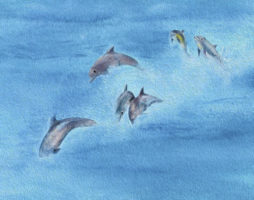 In the dawn of 4 th March, some 300 miles from the Galapagos, a Sperm Whale crashed into the hull of the boat and the outcome was that it sank.
In the dawn of 4 th March, some 300 miles from the Galapagos, a Sperm Whale crashed into the hull of the boat and the outcome was that it sank.
From that moment on this couple would face 117 frenetic days in a small lifesaving raft tied to a small inflatable lifeboat which fortunately they had managed to save.
Amongst their provisions there were several tins of food and 10 gallons of water, sufficient for a few days. They never imagined that this unfortunate mishap would last four months!
During the first few days adrift they came across several merchant vessels as they were still in an area with a certain amount of maritime traffic. But, as always happens in castaway stories on the sea, these boats just carried on their journeys.
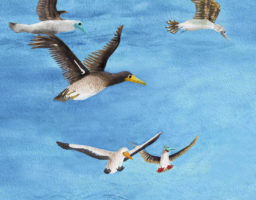 Soon their provisions would run out but, more unfortunate, bit by bit the tide took them further away from the navigation routes until they ended up in one of the most inhospitable regions of the Pacific Ocean, a place where no ships ventured, but with a surprising diversity of marine life. This, being precisely what ended up saving their lives.
Soon their provisions would run out but, more unfortunate, bit by bit the tide took them further away from the navigation routes until they ended up in one of the most inhospitable regions of the Pacific Ocean, a place where no ships ventured, but with a surprising diversity of marine life. This, being precisely what ended up saving their lives.
A few weeks on from their shipwreck, as they went further into the inhospitable ocean, they began to receive unexpected visits of turtles, dolphins, whales, different marine birds and infinity of fish of all shapes, sizes and colours. The surprising thing was to see how all these animals came near the life craft without any fear at all, leaving the couple totally surprised.
Maurice and Maralyn profoundly loved animals but in the middle of the vast ocean, they needed to feed on these creatures in order to stay alive. It wasn’t easy for the couple to sacrifice harmless turtles to eat them crude, but their necessity of survival took precedence.
Soon they had to do the same with the innocent sea birds that landed on the raft and which were ignorant of any danger from these two predators. As occurred with the rest of the captures, they ate the birds crude and drank their blood.
As inflatable rafts are made to float for only a few weeks, theirs began to deteriorate. The first to suffer was the door and then the joints between the floats and finally the systematic loss of pressure.
Both day and night they took turns every half hour to pump air and bail out water and on stormy days, which could last up to a week, this tiring work was carried out without the minimum possibility of rest. During these terrifying nights, blasts of water entered with each wave without cease.
For four months at the mercy of the waves and rain neither of them was able to keep dry and due to the rubbing of plastic against salt, the feared ulcers soon appeared.
After a month adrift Maurice lost all hope of a possible rescue. Neither of them was religious but Marylin was a firm believer in destiny, and that helped Maurice to carry on and not give up.
However, the animals always stayed near the couple. It seemed as if they were there to look after them. “It wasn’t necessary to kill a bird or a Booby. When a Booby sat by my side I would get hold of it and it would drop the fish it had in its mouth, and we would eat that fish as our lunch” Maurice told me, very emotional in the video.
After so many weeks at sea, little by little these two castaways began a profound personality change. They began losing all contact with their past life on land due to the long period of time surrounded by water and after so much time without any sign of the modern world.
Because of being such a long time living close to these animals Maurice and Maralyn assumed that they now belonged to the sea. They were convinced they had changed into two sea creatures, completely forgetting their lives in civilization.
So important was this transformation that when they were finally rescued their feelings were quite confused “I couldn´t believe I was going back to civilization to live again as humans, the sea was now our life, and all those animals were our friends…”
This happened on 30 th June, 1973. After months without sight of a ship or boat on the horizon a fishing boat with a Korean flag appeared in the middle of the vast ocean. This time it did see them.
You can continue reading the full story below. But if you wish to know more about Maurice’s personality please have a look to this other article I wrote. Like I usually do with all my favorite castaways, we have also created these colorful pantings and this website as a tribute for both of them.
DEPARTING FROM ENGLAND
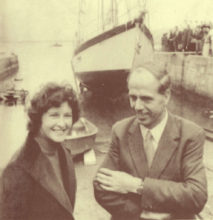 This English couple were two unspoiled nature lovers living in complete solitude and they used to make frequent trips to the mountains and the lakes. Although their real passion was the sea, unfortunately with their limited salaries they couldn’t afford a boat.
This English couple were two unspoiled nature lovers living in complete solitude and they used to make frequent trips to the mountains and the lakes. Although their real passion was the sea, unfortunately with their limited salaries they couldn’t afford a boat.
But in 1966 Maralyn came up with the crazy idea “Let’s sell our house, buy a yacht and live onboard!” The idea sounded impossible to Maurice and he said “No”
“You are not even trying” she replied and began to share her ideas not only for buying a boat but for an ambitious voyage to Oceania. As usual her power of persuasion won, and Maurice quickly became convinced.
They ordered the build of a sailing boat in Plymouth (England) which was going to be 10 meters in length. They called their boat ‘Auralyn’ a combination of their 2 names –Maurice and Maralyn. It took almost 4 years to get it completely ready for the adventure because they also had to prepare all the equipment and improve their sailing skills.
The voyage started in June 1972 from Southampton, and they made stops in Spain, Portugal, Madeira and Canary Islands. Then they crossed the Atlantic Ocean to the American continent. After a few stops on some islands in the Caribbean they finally reached Panama. After crossing the Panama Canal they were ready to sail into the Pacific Ocean.
WHALE ATTACK
During the early morning of their 7th day at sea when it was just light, as Maralyn and Maurice were below preparing breakfast, there was an alarming ‘bang’, and the boat shook so violently that books and tools that were firmly stowed fell across the cabin.
Racing out onto the deck they discovered an awesome 12 meter sperm whale which, having surfaced alongside the boat, had smashed its great tail against the hull of the yacht. It is well said that for those in a boat who feel threatened by whales should start an engine or bang on the hull, because mechanical noises can warn a whale that the boat is not another animal, which could be a rival whale or a source of food.
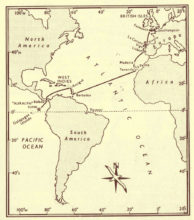 “The poor animal was bleeding extensively from a wound we could not see and it was close to death” Maurice said.
“The poor animal was bleeding extensively from a wound we could not see and it was close to death” Maurice said.
They were in the deck watching that great noble beast wild with pain, blood pouring from its flesh, and surprisingly Maurice and Maralyn instead of being angry they were sorry for her. Then they discovered water rising in the cabin and so Maralyn quickly began to operate one of the two water pumps while Maurice searched for the damage.
He was horrified when he found a big hole in the hull just below the waterline on one side of the boat. They tried to block the hole from outside by dragging a sail under the hull. They also stuffed cushions and clothes into the hole but they also failed to stop the rise of water. There must have been more damage elsewhere but they couldn’t find it. Their attempts to save the boat had failed and they both realized they had to abandon the vessel without delay.
While Maurice released the liferaft and inflated the little dinghy they had on board, Maralyn took on the most precarious job of wading through the rising water below decks collecting food and equipment from submerged lockers despite the fact that she couldn’t even swim.
Maralyn put as much as she could find into two sail bags together with the emergency survival pack and dropped them into the dinghy. In the meantime Maurice had collected all the fresh water containers he could find and tossed them into the dinghy as well.
 Unlike the shipwreck of Steven Callahan –whose boat sank really quickly- the boat of Maurice and Maralyn provided them enough time to collect as much as they could. Fortunately for them, the day was also calm and it was during daylight. After loading everything into their two new floating devices, they sat in the liferaft and watched their little ship slip below the surface of the sea. Barely an hour had passed since the whale attack. Their beloved sailing boat disappeared, and then they started to be consumed by a sense of vulnerability and anxiety.
Unlike the shipwreck of Steven Callahan –whose boat sank really quickly- the boat of Maurice and Maralyn provided them enough time to collect as much as they could. Fortunately for them, the day was also calm and it was during daylight. After loading everything into their two new floating devices, they sat in the liferaft and watched their little ship slip below the surface of the sea. Barely an hour had passed since the whale attack. Their beloved sailing boat disappeared, and then they started to be consumed by a sense of vulnerability and anxiety.
FOOD SUPPLIES AND EQUIPMENT
Fortunately, they were able to rescue some canned food and water to last for about 20 days. They could also save some equipment like a sextant, maps and a compass. Two empty buckets to fill rainwater, one box of matches, one flashlight, one pair of scissors, one binoculars, six emergency flares, a bag with clothes and some other less useful stuff.
So, during the first days they survived from the canned food. But after a week they decided they had to try to find other sources of food or else they would finish the rest of the cans in a week. That’s when they caught their first turtle which was one of the most unpleasant experiences in their lives.
CRAZY ROWING ON THE FIRST DAYS
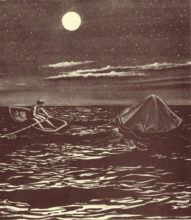 Maurice’s calculations with his sextant showed they were about 300 miles north-east of the Galápagos Islands. The prevailing winds and sea-currents would take them north-west away from these islands and out into the middle of the Pacific if they did not do something quickly. So, they evolved the ‘crazy’ plan to make the effort to row towards the south and try to reach the Galápagos. It was obviously not a great idea because trying to move a liferaft by paddling is the fastest way to waste energy and water from your body.
Maurice’s calculations with his sextant showed they were about 300 miles north-east of the Galápagos Islands. The prevailing winds and sea-currents would take them north-west away from these islands and out into the middle of the Pacific if they did not do something quickly. So, they evolved the ‘crazy’ plan to make the effort to row towards the south and try to reach the Galápagos. It was obviously not a great idea because trying to move a liferaft by paddling is the fastest way to waste energy and water from your body.
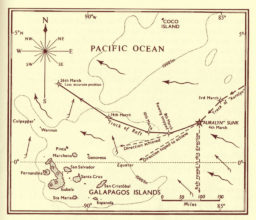 Constantly for every minute of the day and night they rowed. Through the torrid heat of the day and the cold night they rowed. While one paddled the other rested. They continued with their exhausting efforts for three days and three nights until they realized that they hadn’t moved at all.
Constantly for every minute of the day and night they rowed. Through the torrid heat of the day and the cold night they rowed. While one paddled the other rested. They continued with their exhausting efforts for three days and three nights until they realized that they hadn’t moved at all.
Their struggle had been in vain and they were now ‘dead’. Lack of food and sleep had made them weaker. Already they had lost their initial fitness and energy. Their water consumption had been particularly high and the now they had enough water to last for only five more days. The only chance of replenishing their water supply would be the next time it rained.
SHIP ENCOUNTERS
So as soon as they stopped rowing the wind started to take them northwards to meet all the shipping lanes converging on Panamá (see in the map) and increase the chances to see a ship.
However, experiences of previous castaways at sea, like Steven Callahan or Bill Butler taught us that the sighting of ship, even in commonly used shipping lanes, is very difficult. It might be weeks before one ship came along and then, of course, the crew has to see you. Due to the curvature of the earth’s surface the visible horizon is a mere two miles away, even on the calmest of seas.
Moreover, the small crew that usually works on a cargo spends most their time in the cabins doing activities. On the top of that, the pilots on these big vessels are normally sailing in automatic pilot mode, so they are also distracted doing something else on the ship’s bridge. So, as you can well imagine, a ship wouldn’t only have to come very close to you to have any chance of seeing you, but many other coincidences would need to occur.
They had been adrift for just eight days when they saw the first ship; it could not have been more than a mile and a half away. They were overjoyed to see it. Now thirst and hunger were forgotten as they fired their flares to attract the ship.
But as it usually happens, the ship sailed on and they were overcome with horror and disbelief as it had been so close. During the next four months that they were within the shipping lanes zone they were to see another six vessels. One even came towards them on a dark night, almost close enough to be run down. They waited tensely as it came alongside and they fired their last flare directly at the bridge. But there was no one there to see it.
Another ship, which looked like a naval vessel, actually stopped about a mile from them. Their flares now gone they put some of their clothing into a turtle shell and set fire to them to create smoke. But it was a windy day so the little smoke moved away quickly and horizontally. Again, the crew did not see them and eventually the ship sailed on. Each time it happened, their spirits were completely crushed.
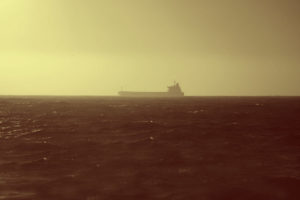 Maralyn wrote in her diary, “Despite all our signals the ships don’t want to see us, so we don’t want to see them”
Maralyn wrote in her diary, “Despite all our signals the ships don’t want to see us, so we don’t want to see them”
Maurice explained, “There seemed so little hope of a ship seeing us. As the days stretched into weeks and the weeks into months, we adjusted to our new surroundings and the ships we saw became an intrusion in our lives and their passing always disturbed us”
During the first weeks, water was a big problem and they had to ration it even more stringently. Daily they only had barely a cupfil each and this was insufficient to maintain their physical well-being.
ANIMALS CAME TO LIVE WITH THEM
Despite all these desperate conditions, they endured. Their time adrift became a period of new enriching experiences as hundreds of fish started to approach the liferaft.
Then these fish were followed by turtles, dolphins, sharks and then birds. As it always happens with most of the castaways at sea, their liferaft is a ‘floating island’ in the sea and within a few days it becomes a miniature ecosystem.
Many fish approached finding shade and shelter. Others to feed on the barnacles that start to grow under the raft. These small fish attracted other bigger fish. In the book ‘117 Days Adrift’ Maralyn mentioned that she even saw a crab sheltering under the raft, in the middle of the Pacific Ocean.
“We found all these animals companionable and they helped to alleviate our isolation. It was a unique and privileged experience. We were seduced by all the creatures we saw at very close quarters, none showing any fear of us at all” Maurice said.
And he continued: “We found ourselves so close to the sea that we became part of the sea, living just like sea creatures ourselves. In our need to survive we had to compete with other animals of the sea for our sustenance”
Hundreds of fish of many species swam below the raft. Dorados, dolphins, sharks, whale sharks, killer whales… Numerous turtles would appear at any time, day or night, and they showed no fear. Birds visited them every day. There were boobies, frigate birds, noddies, and a number of other species.
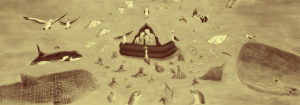 Massive whales would also cruise slowly by them. In the interview I had with him in 2016, Maurice explained how impressed he was by these mammals: “I don’t know if you can really imagine what is like to be sitting on a liferaft, and a whale comes up close to you. So close that we could have reached out to touch it without stretching. It was such a treat to see this whale alongside you! And she did nothing. Just stared at us with her unblinking eye, just straight at us. We were afraid of any quick movement on its part would be enough to upset our liferaft. It sat there for a long time… twenty minutes, half an hour… I got to know her very well and then she went off very slowly, glided away and dived, not a splash. It was marvelous to see that. And then at night we could hear the calls of these whales around us.”
Massive whales would also cruise slowly by them. In the interview I had with him in 2016, Maurice explained how impressed he was by these mammals: “I don’t know if you can really imagine what is like to be sitting on a liferaft, and a whale comes up close to you. So close that we could have reached out to touch it without stretching. It was such a treat to see this whale alongside you! And she did nothing. Just stared at us with her unblinking eye, just straight at us. We were afraid of any quick movement on its part would be enough to upset our liferaft. It sat there for a long time… twenty minutes, half an hour… I got to know her very well and then she went off very slowly, glided away and dived, not a splash. It was marvelous to see that. And then at night we could hear the calls of these whales around us.”
TOWED BY TURTLES
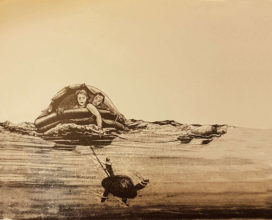 As their goal during the first days was to reach Galapagos, and bearing in mind that turtles were probably coming from those islands, they came up with the curious idea of tying turtles to the raft and see if they would tow them to land.
As their goal during the first days was to reach Galapagos, and bearing in mind that turtles were probably coming from those islands, they came up with the curious idea of tying turtles to the raft and see if they would tow them to land.
They caught a large male and held him upside down in the water and tie a rope in its rear flippers. To their amazement the turtle towed them in the direction of the Galápagos. They were incredibly strong swimmers as this one towed them fast enough to see the ripple of a bow wave. They reasoned that two or three turtles would tow them faster, so they tied a second one. They had visions of driving a ‘team’ right into the harbor.
The vision was quickly shattered when the second turtle began to swim in opposite directions.
KILLING BIRDS
 But unfortunately for them and for the animals, they had to find a means of catching these creatures for their meals. The birds proved to be easiest since they were absolutely not afraid of these two humans.
But unfortunately for them and for the animals, they had to find a means of catching these creatures for their meals. The birds proved to be easiest since they were absolutely not afraid of these two humans.
“Often birds would land alongside us in the dinghy to clean themselves not realizing what dangerous killers we had become” Maurice said.
But what Maurice didn’t know is that some of seabirds -like the boobies or petrels- don’t really have serious predators on land because the desert islands where they breed are usually not inhabited by big mammals except mice and rats. In some of the desert islands we offer in Oceania, our castaway-clients have already experienced how fearless some seabirds are as you can approach them and even touch them with no major issues. Even myself, when I’m in stranded in a remote island there has been some birds that even landed on my head, especially at nighttime when I was wearing a flashlight.
It was the same for Maurice and Maralyn on the liferaft. As there wasn’t any solid rock for hundreds of miles around, seabirds saw this rubber floating device as the perfect spot where they could land. Not only to have a rest, but also to digest the fish they just caught around the ecosystem the liferaft had created. When seabirds landed next to the Baileys all they had to do was to pick them up and wring their necks. They had to eat them all raw.
KILLING TURTLES
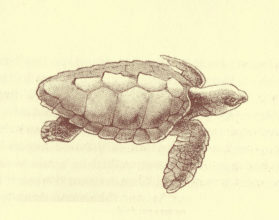 But the turtles, although always around them and easily caught, were quite difficult to kill.
But the turtles, although always around them and easily caught, were quite difficult to kill.
“We would turn the struggling reptile on its back and attempt to hack off its head with my knife. It must have been awful for the poor creature since death did not come quickly. Getting through the leathery skin and neck bones took a very long time and the turtle must have been in excruciating pain before it had been beheaded” Maurice said
They also drank their blood: “Although we tried not to cut through the jugular vein until the last possible moment,
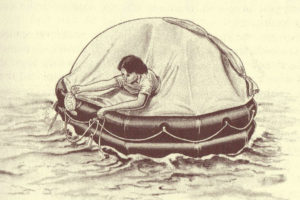 sometimes we struck it early and had to catch the pumping blood while the animal was still alive”
sometimes we struck it early and had to catch the pumping blood while the animal was still alive”
And then Maurice continued: “Having a dead turtle was one thing, we then had to butcher it. Again, it was a struggle for us to cut through the Iower shell for the meat inside”
“How many turtles we caught I cannot be sure but the death of one was never a pleasant occasion. Maralyn and I promised should we survive this ordeal, no animal would suffer at our hands ever again and so eventually we became vegetarians”
In 2016 Maurice confirmed to me that they never eaten meat since this castaway experience.
FISHING
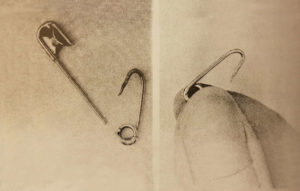 As for the fishes, unfortunately they didn’t have fish-hooks in their survival pack. This error might have had fatal results had it not been for Maralyn’s ingenuity. She discovered some stainless safety pins in their first-aid kit, and she bent these into barbless hooks. Tying each to a piece of string and using turtle meat as bait they were able to begin fishing. Especially trigger fish, which became their main source of food.
As for the fishes, unfortunately they didn’t have fish-hooks in their survival pack. This error might have had fatal results had it not been for Maralyn’s ingenuity. She discovered some stainless safety pins in their first-aid kit, and she bent these into barbless hooks. Tying each to a piece of string and using turtle meat as bait they were able to begin fishing. Especially trigger fish, which became their main source of food.
But later they found they could catch trigger fish just by hand: 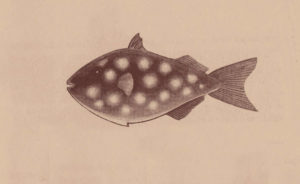 “We discovered that when we attempted to wash our bloodied hands from a turtle kill in the water, they would be seized by numerous ferocious trigger fish. All I had to do then was to bring my hands out of the water and I had caught ten or more fish with my fingers with no effort” Maurice estimated that they consumed about 4.000 of this particular species.
“We discovered that when we attempted to wash our bloodied hands from a turtle kill in the water, they would be seized by numerous ferocious trigger fish. All I had to do then was to bring my hands out of the water and I had caught ten or more fish with my fingers with no effort” Maurice estimated that they consumed about 4.000 of this particular species.
SHARKS
They also caught four sharks and even ate their livers despite the fact that they are not recommended due to excess levels of mercury. It was Maralyn who caught the first shark and she did it for amusement. As Maurice nicely explained in the interview, she would watch the sharks cruising just below the surface under the liferaft and past the entrance.
One day she put her finger on the nose of a shark and let it slide along the body to its tail as it swam past. Every time a shark came near, she would repeat this game. Then Maralyn decided she wanted a little more excitement and she grabbed the fish’s tail, lifted it into to life raft, depositing it next to Maurice leg. He got scared as it was almost 2 meters long and almost filled the liferaft. Fortunately, Maralyn kept a tight hold of its tail and Maurice picked up his knife and drove the blade deep into the shark’s gills. Despite the spurting blood it did not die, and he thrust his knife into its gills several more times. He desperately wrapped a towel tightly around its head until it suffocated.
Maurice hadn’t even finished this task when Maralyn lifted another shark inside, and then a third one. Maurice, under so much stress, didn’t have enough hands to manage them all. It was a very bizarre situation suddenly having three dead sharks inside the little liferaft. However, after these first killings, they discovered tips that made other kills much easier.
1 – Having caught its tail, because of its rough skin, the shark could be held firmly without fear of slipping.
2 – Unlike other fish, its unique primitive skeleton did not allow sharks to turn on its attacker.
3 – When the shark stopped swimming it quickly drowned.
“However, shark meat wasn’t tasty at all, especially raw” Maurice told me.
As it usually happens to most castaways on liferafts, the sharks would swim fast just below the surface of the sea and hit hard against the liferaft floor causing great pain to the couple. Dolphins were also troublesome in this respect. The continual battering they received bruised their skinny bodies.
“The blows were not intentional, and the sharks and dolphins were merely attacking
the fish sheltering below our raft” Maurice said.
But the truth is that sharks and dolphins hit the bottom of liferafts not only because they are hunting fish.
Some experts say they also need to spread their mark –just like dogs on a tree- but also because they need to clean themselves by rubbing their bodies against the bottom of the raft. Moreover, some fish are feeding on barnacles growing just under the liferaft.
SURVIVAL
They wasted nothing from the creatures they caught: “With greedy predilection of the starving we ate all organs raw together with the fat and eggs from the turtles”, Maurice said.
Even the eyes of the fishes were taken out and eaten with relish. “We carefully collected turtle’s blood and after it had congealed, we ate it as though it was a treat at a party” .
Sometimes seabirds used to fight with each other around the raft. For example, frigatebirds would rob a booby’s catch, using their speed to harass their victims until they regurgitate their stomach contents. So, in some occasions, squid or fish fell on the dinghy like rain. And then the Baileys would eat them for their lunch.
Maurice and Maralyn decided to copy the strategy of the frigatebirds and let boobies catch their food for them. “I didn’t need to kill boobies. One day a booby came and sat alongside me. He cleaned himself and I grabbed him. But he didn’t move, he just sat there. And he disgorged six or seven flying fish that we accepted for our meal that day” he said in one of the most fascinating moments of the interview that I had with Maurice in 2016.
“We always felt a sadness for the creatures we killed especially in the manner of their death. We had no right to be there, it was not our domain. It was an ecosystem alien to man and the animals had as much right to life as ourselves”.
DRINKING WATER
But they were lucky in terms of water. Because without water they would have been unable to eat or digest any protein. After having had so little water in their bottles they were grateful to find rain the as they drifted further north. Sometimes they had more water than they could cope with. The drift took them into the Doldrums and the bright sky gave way to a constant grey clouds, with constant showers which made their existence less miserable.
The rain was so heavy and violent that they had to bail water from their fragile liferaft constantly.
Sometimes, for a week at a time, they did not even see the sun. Everything was wet and their bodies were chilled and sore. And the liferaft was so small they had no room to change positions. “We were also so exhausted because we had to bail almost continuously night and day because our liferaft was falling into pieces”, Maurice said
POSITIVINESS
Unlike the Butle’s survival experiencie in 1989, where Simonne blamed his husband bitterly during the 66 days they were adrift, the Baileys had a wonderful relationship and they deeply loved each other.
Maralyn kept a diary day by day. Her notes became a faithful record of their adventures. I asked Maurice to bring the diary to our meeting in England as he was still keeping it at home, and fortunately I could take photos of each page which also helped me a lot to better understand the progression of their mental condition during their 117 days. You can enjoy reading their whole diary on this other post I prepared for those who want to know more deeply about their day-by-day experience.
“Her diary was the only means we had of recording the passage of time. As time passed it seemed as though we had known no other life; it was a plain and brutish life; its progress measured in simple terms of staying alive. For us there was no past and no future – just an interminable present”, Maurice said.
In their book ‘117 Days Adrift’ Maralyn wrote:
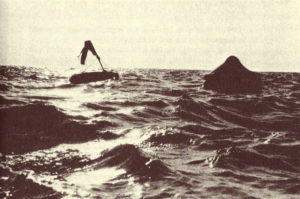 “We explored the hidden depths of each other’s character. We had no secrets, no privacy and no inhibitions. In some weird way we found peace in our complete isolation. We threw away the trappings of so-called civilization and reverted to a simple prehistoric way of life”.
“We explored the hidden depths of each other’s character. We had no secrets, no privacy and no inhibitions. In some weird way we found peace in our complete isolation. We threw away the trappings of so-called civilization and reverted to a simple prehistoric way of life”.
It was Maralyn who always inspired survival, and unlike Maurice, she had a positive aversion to despair. “If we were two men on the life raft we wouldn’t have survived because it was Maralyn who was the one who sustained the will to live. And that is what females usually do”, Maurice told me in our interview.
Maurice didn’t believe in God at all. But Maralyn believed that much of what happened to them was pre-destined. Her faith in some supernatural power governing their journey was never weakened.
“There must be a reason why we had survived so far so long”, Maralyn used to tell him.
CURRENTS TOWARDS LAND
As their drift was sending them to the north-west, their hope was to reach the east-going counter current (see map below) on about the 45th day. This current would hopefully send them back to Panama. And when they reached the 45th day, their calculations showed that they were right and they began to gradually move to the east, back towards the mainland. Even though they were cold, wet and in continual pain from saltwater sores, they were full of renewed optimism.
But after 20 more days struggling in the Doldrums, the world collapsed around them; their drift was no longer easterly. The north equatorial current suddenly appeared and they started to go westward again back into the middle of the Pacific. Sadness and despair now overcame both of them.
During storms they could not fish at all so they both looked wasted and weak. Their skin stretched tightly over their bones. Their saltwater sores were terribly painful right from the first week, but now they could hardly move.
BAILING WATER CONTINUOUSLY
After they had been adrift for 51 days, they had the misfortune to puncture the dinghy with one of their fish-hooks made from safety pins. A few days later the spines of a trigger fish punctured the liferaft. Things could not have been more desperate; now the task of inflating the two craft several times a day in their weak and starving condition drained their stamina. But actually, they were lucky to have two crafts and not one like most of castaways at sea. For example, in 1989 castaway Bill Butler also punctured his liferaft very badly, but it was his only means of flotation.
Like most liferafts, Maurice and Maralyn found the fabric of its vital ‘roof ’-their only shelter from the elements- was falling off, becoming rotten and useless. The velcro ‘door’ fastening became ineffective and the slightest breeze would whip the door open, so during storms they were completely exposed to the rain and waves, bailing water nonstop.
Maurice became ill, developing a fever and chronic chest pains, coughing up blood in alarming quantities. Every movement caused intense pain, so much so that he could do nothing to help Maralyn in the daily survival routine. “I was tormented by guilt; how was Maralyn going to help without me?”
The symptoms persisted for many days and he remained in a semiconscious state, thinking he was already dead. During storms the dinghy overturned several times and the effort of righting it was so exhausting it brought them to the point of collapse.
During storms it was not possible to fish but as some storms lasted for several days Maurice, full of starvation, had no choice but to move into the dinghy and try fishing. 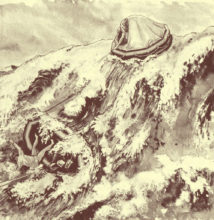 But a strong gust of wind flipped the dinghy over and threw him into the sea, washing him some way off. When he climbed back into the dinghy he watched with alarm as the accident tossed tons of water over the liferaft along with their last fish hooks. “We lost much of our valuable equipment during the storms. Our ulcerated bodies grew more painful, the sea remained rough and the raft and dinghy had to be either baled or inflated continuously”.
But a strong gust of wind flipped the dinghy over and threw him into the sea, washing him some way off. When he climbed back into the dinghy he watched with alarm as the accident tossed tons of water over the liferaft along with their last fish hooks. “We lost much of our valuable equipment during the storms. Our ulcerated bodies grew more painful, the sea remained rough and the raft and dinghy had to be either baled or inflated continuously”.
Gradually the rains eased, the sea became calmer and the skies cleared. With the improvement in the weather came the realization they were drifting out of the Doldrums area –less rain and marine life- into a possible oceanic emptiness. Even if their physical health did not decline further and the dinghy and raft remained intact, they knew the further west they went the more likely they were to die. Death by thirst and starvation might be just a matter of days away. They were drifting in the last shipping lane just before entering the wastes of the Pacific. They had to be seen by a ship in the next few days or they were going to die.
RESCUE
The 117th day of their ordeal started with a calm sea. From dawn they caught some fish. Then they bailed and inflated the raft and dinghy. After some hours of rest, during the early afternoon, Maralyn tried to wake Maurice up but he refused. But she continued, “I can hear a ship’s engine”. In his confused drowsiness Maurice wondered if this was the start of a madness. “Ships had long ceased to be a part of our lives. We had not seen one for 45 days. Reluctantly I stared in the direction Maralyn was pointing. A fishing boat had appeared on the horizon!” With some difficulty they raised their frail bodies on to their feet and, using their remaining strength, they waved their oilskins at the ship. But, like all the others, it was sailing on. Maurice dropped to his knees with exhaustion, full of despair.
I said to Maralyn, “Let it go on. Save your strength. This is our life now on the sea among the fishes, birds and turtles” Maurice took no further interest in the ship. But then she said quietly, “It’s coming back!” The ship had indeed changed direction and was slowly coming towards them. This time the rescue was real. “At that moment I think we both knew for the first time the real joy of being alive”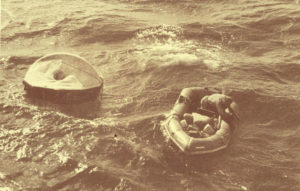
“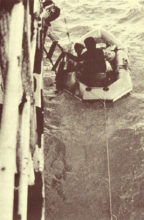 Our means of returning to civilization was approaching. Even then, our happiness was tempered by a feeling of sadness at the prospect of leaving our life on the sea where we had competed successfully for our right to live. We would be leaving an area of peace where we had gained a remarkable understanding of the ocean and its vast ecosystem”
Our means of returning to civilization was approaching. Even then, our happiness was tempered by a feeling of sadness at the prospect of leaving our life on the sea where we had competed successfully for our right to live. We would be leaving an area of peace where we had gained a remarkable understanding of the ocean and its vast ecosystem”
- Maurice had a mix of feelings: “The sea was our life, the animals were our neighbors. I couldn’t believe that we were going back to human civilization and we were wondering what civilization has to offer us now” he said in our interview.
It was the 30th of June of 1973. ‘Weolmi306’ was a South Korean fishing boat that had spent two years in the Atlantic based in Tenerife fishing for tuna. Its work was now finished, and it was on its way home to Busan (Korea). Maurice and Maralyn were extremely fortunate the vessel happened to be a fishing boat.
The captain had extra hands to keep busy and he occupied them with extra lookout duties. Being fishermen, the crew were used to spotting unusual things on the surface of the sea. A voice came down to the raft from the deck, “Do you speak English?” “I’m sorry, but we are English” A different voice replied, “If you’re Russian, big trouble” -It was still the Cold War-
They were helped up a rope ladder and sat on the deck. The first thing they drank was milk. “The crew treated us with extreme kindness”, Maurice said The ship was diverted to Honolulu for them to receive medical attention. Physically they were in very poor shape. And like the Steven Callahan and Bill Butler, their muscles legs were atrophied to a state where they could barely walk. There, they were left with their memories….
MEDICAL EXAMINATION
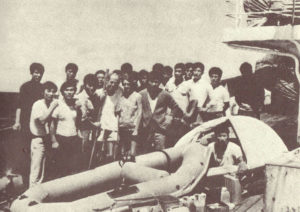 During the whole experience, they worried about the lack of vitamins and the risk of suffering scurvy. The medical examination after the rescue revealed a vitamin deficiency. But no sign of scurvy. Maurice mentioned in his book that perhaps the fish’s eyes they ate provided a rich source of Vitamin C. But I think the lack of scurvy was just because they were eating fish, turtles and the birds, all of them raw. And these animals contain certain amounts of Vitamin C – especially in the liver- but these vitamins disappear after cooking.
During the whole experience, they worried about the lack of vitamins and the risk of suffering scurvy. The medical examination after the rescue revealed a vitamin deficiency. But no sign of scurvy. Maurice mentioned in his book that perhaps the fish’s eyes they ate provided a rich source of Vitamin C. But I think the lack of scurvy was just because they were eating fish, turtles and the birds, all of them raw. And these animals contain certain amounts of Vitamin C – especially in the liver- but these vitamins disappear after cooking.
That’s the reason Inuits can survive winters without vegetables. Unfortunately, old sailors in previous centuries used to cook their fish on their ships and they killed the necessary Vitamin C, and that’s one of the reason why they often suffered from scurvy.
Maralyn and Maurice’s diet was composed almost entirely of protein so it was a little surprising to learn from the medical examination that they also had a protein deficiency.
Doctors also said that Maurice suffered from deep vein thrombosis and he had inhaled a blood clot into his lung, damaging it irreversibly.
Both of them had anemia, especially Maurice. The ulcers healed quickly after their rescue. Maralyn had had no menstrual periods for three months.
 Maurice told me that he also became almost deaf in one of his ears due to an infection he got in the liferaft. And his other ear became affected with old age. During our interview, communication was quite difficult.
Maurice told me that he also became almost deaf in one of his ears due to an infection he got in the liferaft. And his other ear became affected with old age. During our interview, communication was quite difficult.
In this long article I have tried my best to tell the most interesting events of this fascinating adventure. You can find out more in this other article I wrote about their lives before and after the accident, also in this other article you can learn how they both met and the love they both had for each other. And the full diary you can read it here.
If you wish to know more about this experience you can ask me in the comments below and I will share more details of the conversations I had with Maurice Bailey before he passed away last year. I strongly recommend you to read their book written in 1974 ‘117 DAYS ADRIFT / STAYING ALIVE’ that you can buy in Amazon-
FOLLOW OUR CASTAWAY STORIES ON INSTAGRAM
FOLLOW OUR CASTAWAY STORIES ON FACEBOOK
FOLLOW OUR CASTAWAY STORIES ON YOUTUBE
—

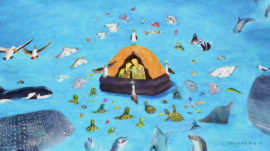

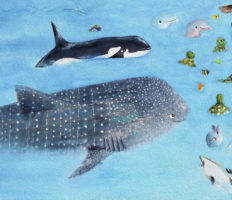
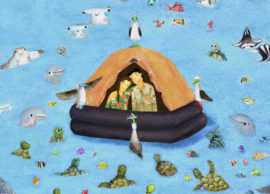
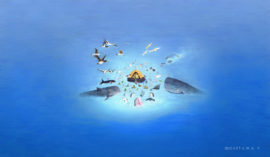
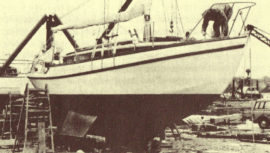
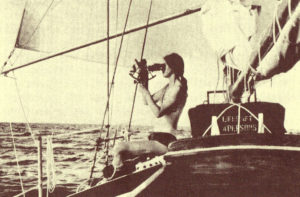

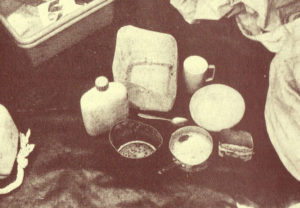


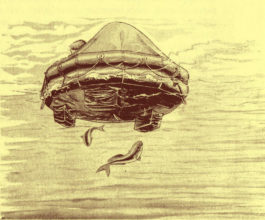
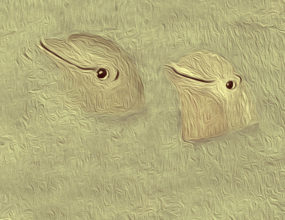


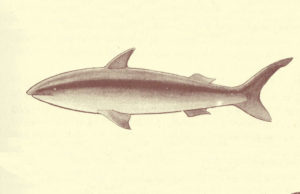


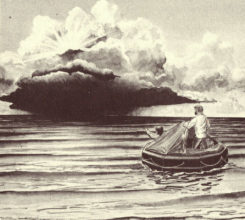
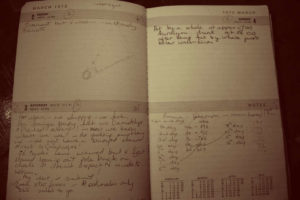
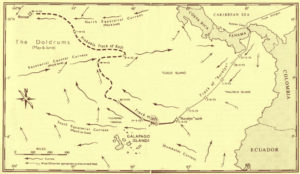
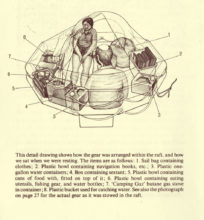
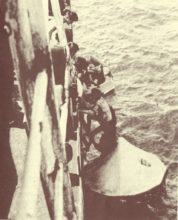
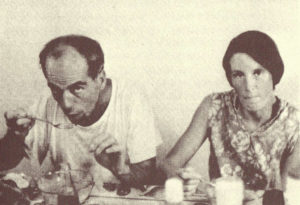

{ 0 comments… add one now }
{ 1 trackback }